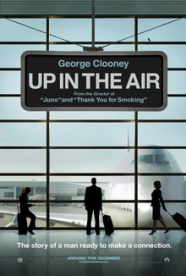6/10
I’ll make a confession: I saw the movie first.
I’d never seen the 2009 Academy Award nominee, and didn’t have a clue that it was based off of a book at all. I did enjoy the movie, but more on that in a minute; first, let’s discuss Kirn’s work.
The premise of Up in the Air is that Ryan Bingham spends a lot of time in the air. In fact, travelling is almost his full-time job. He spends his days flying from city to city, and in between he visits companies to help them fire employees, and then counsels those former employees to make their transitions easier. All this being said, Ryan spends little of the novel on airplanes. Instead of following him through airports and experiencing his flights with him, we get a lot of him talking about characters we’ve only barely met, going on benders in Las Vegas casinos, and then we have to read large portions of the ‘book’ he is writing. If you can even call it a book, since it reads more like the ramblings of a madman.
The real problem with the novel is the execution; the story itself should be interesting. Ryan is trying to travel one million miles with an airline, and he needs to do it before his boss gets back from vacation to read the resignation letter sitting on his desk. In the meantime, he still has to do his current job, attempt to find a new position, and make it to his sister’s wedding (with a side helping of also tracking down his sister, who seems to be suffering from a case of cold feet). But while on the surface the plot should be interesting and humorous, in reality Bingham is slowly losing his mind. He’s not only an unreliable and deeply unlikable narrator, but also a pitiable one. Another flaw of the execution is that it is impossible to grasp any other character. While this might make sense if the supporting cast was a revolving door of people who flit in and out of the story as Ryan swoops all over the country, instead the same eight to ten people keep popping up in Ryan’s life, and yet we don’t know any of them.
Among other problems was that the story dragged on, and that the ending was confusing. I’m all for ambiguous endings, but this one was just a let-down after suffering through the rest of the book in the hopes of some sort of conclusion. In general, the book also hasn’t aged particularly well. This isn’t a fault of the author, as he couldn’t have predicted how much flying has changed since he wrote it in 2000/2001, but it was still disconcerting to be reading it in 2017.
So… what about the movie?

The movie and book share little more than some fundamental elements. While both have a character by the name of Ryan Bingham who travels a lot, the movie’s version (played by George Clooney) is much more likable. Ryan’s sister is also still getting married, but here the similarities pretty much end. The movie adds several characters (including those played by Vera Farmiga and Anna Kendrick), and then removes most of the unsavory players from Kirn’s version. The film also makes the plot much more focused on Ryan’s main goal, which is now ten million miles, instead of just one. Released in 2009, the movie even goes so far as to have a message, pitting Clooney and Kendrick’s characters on either side of a technological advance, with both struggling with their task to fire people they’ve never met, especially in an unstable economy. And even with this heavy message, the movie manages to have several lighter moments, and even some very funny scenes, which is more than can be said of the source material. The ending of the movie, while also not much happier than the book, at least makes more sense with the arc of the movie’s plot. Overall, I’d rate the movie a solid 8/10.

Quick fun fact for anyone still reading, the novel Up in the Air didn’t do very well when first released in 2001. While this might have been because it wasn’t that great of a book, often cited is that the original cover included people-plane hybrids crashing into each other, as seen below. Since this image was found to be so distasteful, the cover that can be found at the beginning of this post was released in 2002, and is now the widely accepted cover.






